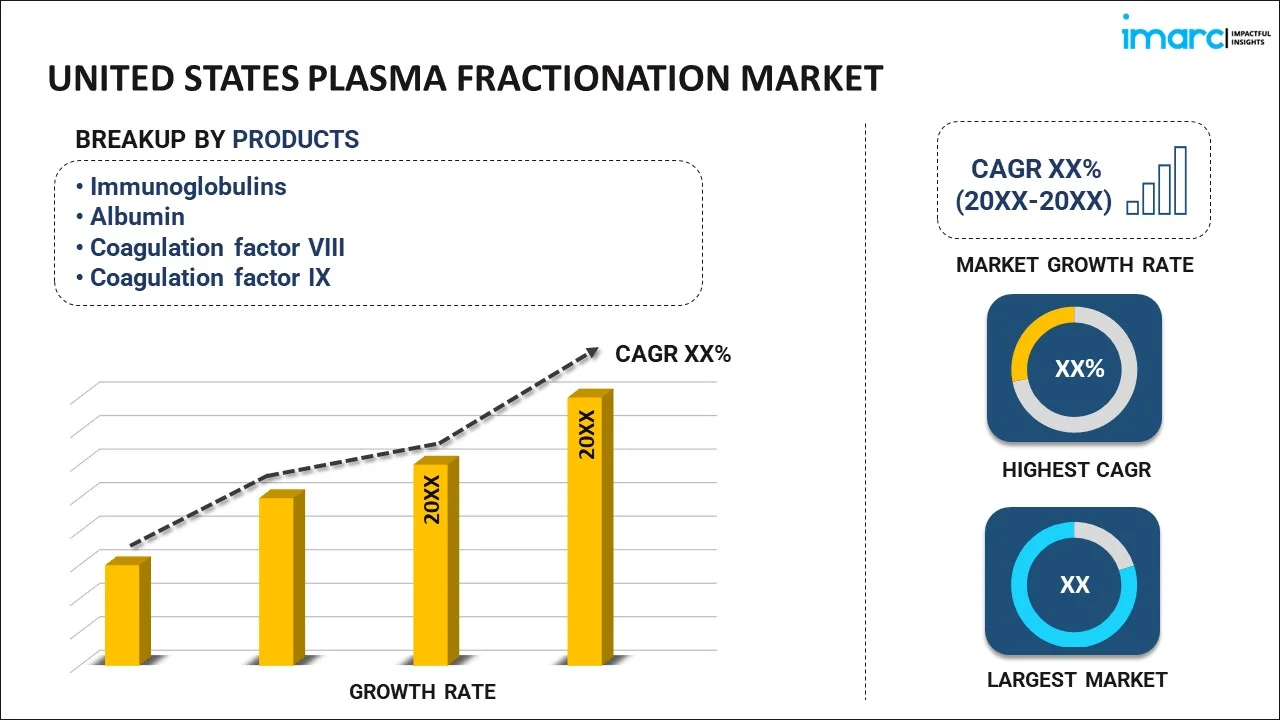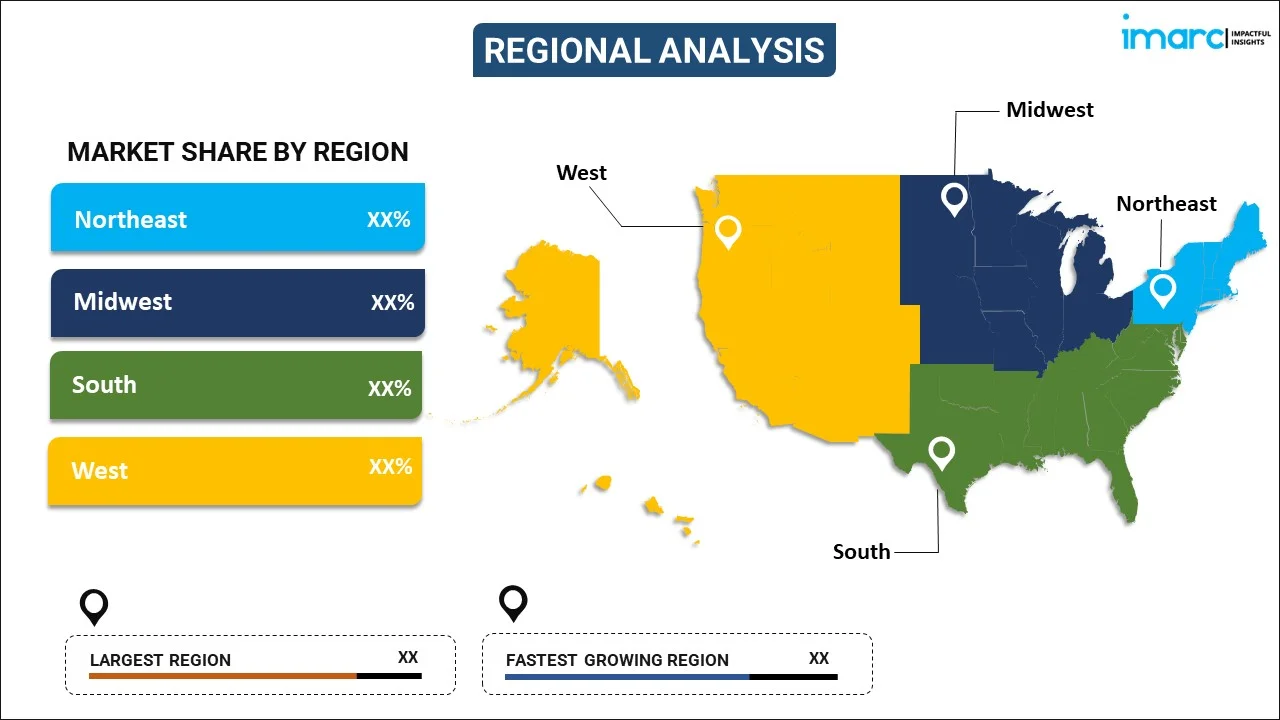
United States Plasma Fractionation Market Report by Product (Immunoglobulins, Albumin, Coagulation factor VIII, Coagulation factor IX), Sector (Private Sector, Public Sector), Application (Neurology, Immunology, Hematology, and Others), End User (Hospitals and Clinics, Clinical Research Laboratories, Academic Institutes), and Region 2025-2033
Market Overview:
United States plasma fractionation market size is projected to exhibit a growth rate (CAGR) of 7.41% during 2025-2033. The escalating demand for these life-saving products, driven by factors, such as increasing prevalence of chronic diseases and advancements in medical research, is primarily augmenting the market growth.
|
Report Attribute
|
Key Statistics
|
|---|---|
|
Base Year
|
2024 |
|
Forecast Years
|
2025-2033 |
|
Historical Years
|
2019-2024
|
| Market Growth Rate (2025-2033) | 7.41% |
Plasma fractionation involves the processing of donated plasma into essential therapeutic treatments and medicinal products. This procedure divides plasma into distinct proteins or plasma fractions through mechanical separation techniques, including centrifugation, depth filtration, precipitation, and chromatography. Contemporary fractionation processes often employ alcohol concentrations, along with precise control of time, temperature, and pH, to extract particular therapeutic proteins. The evolution of technology complexity and the incorporation of in-process viral reduction treatments over time have led to advancements in the development of novel protein therapeutics. Simultaneously, these advancements contribute to enhancements in the purity and quality of the final products derived from plasma fractionation.
United States Plasma Fractionation Market Trends:
The United States plasma fractionation market is witnessing significant growth and innovation, driven by the crucial role it plays in transforming donated plasma into life-saving therapeutic treatments. This intricate downstream processing involves breaking down plasma into individual proteins or fractions through mechanical separation techniques like centrifugation, depth filtration, precipitation, and chromatography, which is acting as another significant growth-inducing factor. Moreover, advancements in technology have introduced sophisticated fractionation processes that utilize precise control over alcohol concentrations, time, temperature, and pH to extract specific therapeutic proteins, thereby positively influencing the regional market. Apart from this, the evolving complexity of these processes, coupled with the integration of in-process viral reduction treatments, has not only improved the quality and purity of derived products but has also spurred the development of novel protein therapeutics. In the U.S., the plasma fractionation market is a cornerstone in the healthcare industry, supplying essential therapies for various medical conditions. As the market evolves to meet these demands, it contributes significantly to the enhancement of healthcare outcomes, positioning the United States at the forefront of plasma fractionation advancements. This, in turn, is expected to fuel the regional market over the forecasted period.
United States Plasma Fractionation Market Segmentation:
IMARC Group provides an analysis of the key trends in each segment of the market, along with forecasts at the country level for 2025-2033. Our report has categorized the market based on product, sector, application, and end user.
Product Insights:

- Immunoglobulins
- Albumin
- Coagulation factor VIII
- Coagulation factor IX
The report has provided a detailed breakup and analysis of the market based on the product. This includes immunoglobulins, albumin, coagulation factor VIII, and coagulation factor IX.
Sector Insights:
- Private Sector
- Public Sector
A detailed breakup and analysis of the market based on the sector have also been provided in the report. This includes private sector and public sector.
Application Insights:
- Neurology
- Immunology
- Hematology
- Others
The report has provided a detailed breakup and analysis of the market based on the application. This includes neurology, immunology, hematology, and others.
End User Insights:
- Hospitals and Clinics
- Clinical Research Laboratories
- Academic Institutes
A detailed breakup and analysis of the market based on the end user have also been provided in the report. This includes hospitals and clinics, clinical research laboratories, and academic institutes.
Regional Insights:

- Northeast
- Midwest
- South
- West
The report has also provided a comprehensive analysis of all the major regional markets, which include Northeast, Midwest, South, and West.
Competitive Landscape:
The market research report has also provided a comprehensive analysis of the competitive landscape. Competitive analysis such as market structure, key player positioning, top winning strategies, competitive dashboard, and company evaluation quadrant has been covered in the report. Also, detailed profiles of all major companies have been provided.
United States Plasma Fractionation Market Report Coverage:
| Report Features | Details |
|---|---|
| Base Year of the Analysis | 2024 |
| Historical Period | 2019-2024 |
| Forecast Period | 2025-2033 |
| Units | Million USD |
| Scope of the Report | Exploration of Historical Trends and Market Outlook, Industry Catalysts and Challenges, Segment-Wise Historical and Future Market Assessment:
|
| Products Covered | Immunoglobulins, Albumin, Coagulation factor VIII, Coagulation factor IX |
| Sectors Covered | Private Sector, Public Sector |
| Applications Covered | Neurology, Immunology, Hematology, Others |
| End Users Covered | Hospitals and Clinics, Clinical Research Laboratories, Academic Institutes |
| Regions Covered | Northeast, Midwest, South, West |
| Customization Scope | 10% Free Customization |
| Post-Sale Analyst Support | 10-12 Weeks |
| Delivery Format | PDF and Excel through Email (We can also provide the editable version of the report in PPT/Word format on special request) |
Key Questions Answered in This Report:
- How has the United States plasma fractionation market performed so far and how will it perform in the coming years?
- What has been the impact of COVID-19 on the United States plasma fractionation market?
- What is the breakup of the United States plasma fractionation market on the basis of product?
- What is the breakup of the United States plasma fractionation market on the basis of sector?
- What is the breakup of the United States plasma fractionation market on the basis of application?
- What is the breakup of the United States plasma fractionation market on the basis of end user?
- What are the various stages in the value chain of the United States plasma fractionation market?
- What are the key driving factors and challenges in the United States plasma fractionation?
- What is the structure of the United States plasma fractionation market and who are the key players?
- What is the degree of competition in the United States plasma fractionation market?
Key Benefits for Stakeholders:
- IMARC’s industry report offers a comprehensive quantitative analysis of various market segments, historical and current market trends, market forecasts, and dynamics of the United States plasma fractionation market from 2019-2033.
- The research report provides the latest information on the market drivers, challenges, and opportunities in the United States plasma fractionation market.
- Porter's five forces analysis assist stakeholders in assessing the impact of new entrants, competitive rivalry, supplier power, buyer power, and the threat of substitution. It helps stakeholders to analyze the level of competition within the United States plasma fractionation industry and its attractiveness.
- Competitive landscape allows stakeholders to understand their competitive environment and provides an insight into the current positions of key players in the market.
Need more help?
- Speak to our experienced analysts for insights on the current market scenarios.
- Include additional segments and countries to customize the report as per your requirement.
- Gain an unparalleled competitive advantage in your domain by understanding how to utilize the report and positively impacting your operations and revenue.
- For further assistance, please connect with our analysts.
 Request Customization
Request Customization
 Speak to an Analyst
Speak to an Analyst
 Request Brochure
Request Brochure
 Inquire Before Buying
Inquire Before Buying




.webp)




.webp)












